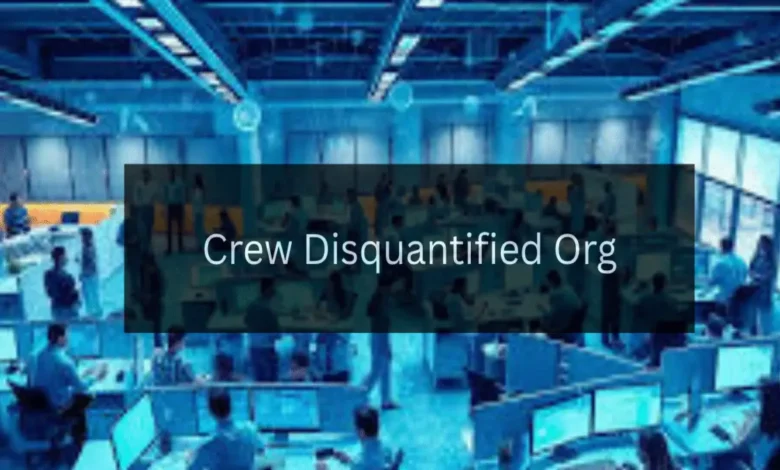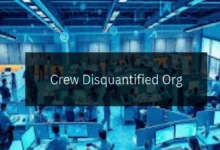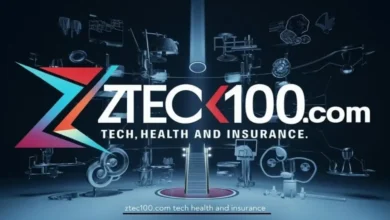Crew Disquantified Org: The Next Evolution in Organizational Workforce Strategy

Introduction
In today’s rapidly evolving business landscape, organizations are constantly seeking innovative ways to optimize workforce efficiency, reduce operational costs, and enhance productivity. One emerging concept that is reshaping workforce strategy is “Crew Disquantified Org”—a data-driven approach that leverages artificial intelligence (AI), machine learning (ML), and advanced analytics to redefine how teams are structured, managed, and optimized.
But what exactly does “Crew Disquantified Org” mean, and why is it being hailed as the next evolution in workforce strategy? This article explores the concept in depth, examining its benefits, challenges, real-world applications, and future implications for businesses across industries.
What is Crew Disquantified Org?

The term “Crew Disquantified Org” refers to an organizational model where traditional workforce quantification (fixed roles, rigid hierarchies, and static team structures) is replaced with a dynamic, data-driven approach. Instead of relying on outdated metrics like headcount and fixed schedules, companies use real-time analytics to:
- Optimize team composition based on skills, workload, and project demands.
- Predict workforce needs using AI-powered forecasting.
- Enhance flexibility by dynamically adjusting crew sizes and roles.
- Reduce inefficiencies by eliminating overstaffing or understaffing.
This shift allows businesses to move from a “quantified” (fixed and rigid) workforce model to a “disqualified” (fluid and adaptive) one, ensuring maximum efficiency and agility.
Why Traditional Workforce Models Are Failing
Many organizations still rely on traditional workforce management methods, which often lead to:
- Overstaffing or Understaffing – Fixed schedules and rigid roles make it difficult to adjust to fluctuating demands.
- Skill Gaps – Static job descriptions don’t account for evolving project requirements.
- Low Employee Engagement – Inflexible structures reduce adaptability and job satisfaction.
- High Operational Costs – Inefficient staffing leads to wasted resources.
The Crew Disquantified Org model addresses these challenges by introducing AI-driven workforce optimization, ensuring that the right people are in the right roles at the right time.
Key Components of a Crew Disquantified Org
To successfully implement this model, organizations must integrate the following elements:
1. AI-Powered Workforce Analytics
- Predictive analytics to forecast labor needs.
- Real-time performance tracking to adjust workloads dynamically.
2. Dynamic Team Structuring
- Fluid roles that adapt to project demands.
- Cross-functional teams assembled based on skills rather than fixed departments.
3. Automated Scheduling & Task Allocation
- Smart scheduling tools that optimize shifts based on demand.
- AI-driven task assignments to maximize efficiency.
4. Continuous Learning & Upskilling
- AI-recommended training programs to fill skill gaps.
- Adaptive learning paths for employees to stay relevant.
5. Employee-Centric Flexibility
- Personalized work arrangements (remote, hybrid, gig-based).
- Real-time feedback loops to improve engagement.
Industries Benefiting from Crew Disquantified Org
Several sectors are already adopting this model with impressive results:
1. Logistics & Supply Chain
- Dynamic crew allocation in warehouses based on real-time order volumes.
- Predictive staffing for peak seasons (e.g., holidays).
2. Healthcare
- AI-driven nurse scheduling to match patient influx.
- On-demand staffing for emergency response teams.
3. Retail & Hospitality
- Smart shift scheduling to align with customer footfall.
- Gig-based staffing for seasonal demand spikes.
4. Tech & IT
- Agile project teams are formed based on skill requirements.
- AI-driven developer allocation for sprint cycles.
5. Manufacturing
- Automated workforce optimization for production lines.
- Predictive maintenance crews deployed based on AI alerts.
Challenges & Risks of Implementing Crew Disquantified Org
While the benefits are compelling, organizations must navigate potential hurdles:
1. Data Privacy & Security Concerns
- Workforce analytics rely on employee data, raising privacy issues.
- Compliance with GDPR and other regulations is critical.
2. Resistance to Change
- Employees may fear job instability due to dynamic roles.
- Leadership must foster a culture of adaptability.
3. Over-Reliance on AI
- Human judgment is still essential for ethical decisions.
- AI models must be transparent and explainable.
4. Implementation Costs
- Advanced AI tools and training require investment.
- ROI may take time to materialize.
The Future of Crew Disquantified Org
As AI and automation continue to advance, the Crew Disquantified Org model will become the standard for workforce management. Future trends include:
- Hyper-Personalized Work Environments – AI tailoring roles to individual strengths.
- Blockchain for Workforce Verification – Secure, decentralized credentialing.
- Augmented Reality (AR) for Remote Collaboration – Virtual crew coordination.
- Ethical AI Governance – Ensuring fairness in automated workforce decisions.
Organizations that embrace this evolution will gain a competitive edge, while those clinging to outdated models risk falling behind.
Conclusion
The “Crew Disquantified Org” represents a paradigm shift in workforce strategy, moving from rigid structures to intelligent, adaptive systems. By leveraging AI, real-time analytics, and dynamic team structuring, businesses can achieve unprecedented efficiency, cost savings, and employee satisfaction.
While challenges exist, the long-term benefits make this model inevitable for forward-thinking organizations. The future of work is not fixed—it’s fluid, and the Crew Disquantified Org is leading the way.
Is your organization ready to embrace the next evolution in workforce strategy?
SEO Optimization Notes for This Article
- Primary Keyword: “Crew Disquantified Org”
- Secondary Keywords: AI workforce optimization, dynamic team structuring, predictive workforce analytics, agile workforce management
- Meta Description: Discover how Crew Disquantified Org is revolutionizing workforce strategy with AI-driven optimization, dynamic team structuring, and predictive analytics.
- Internal Links: Link to related articles on AI in HR, workforce analytics, and agile management.
- External Links: Reference studies from McKinsey, Gartner, or Deloitte on future workforce trends.
Would you like any refinements or additional sections?
Here are 5 FAQs based on your article “Crew Disquantified Org: The Next Evolution in Organizational Workforce Strategy”—optimized for SEO and reader engagement:
1. What does “Crew Disquantified Org” mean?
Answer:
“Crew Disquantified Org” refers to a modern workforce strategy where organizations move away from rigid, fixed team structures (“quantified”) and instead adopt AI-driven, dynamic workforce optimization (“disquantified”). This approach uses real-time data, predictive analytics, and automation to adjust team sizes, roles, and schedules for maximum efficiency.
2. How does Crew Disquantified Org improve workforce efficiency?
Answer:
By leveraging AI-powered analytics and automation, Crew Disquantified Org:
- Eliminates overstaffing/understaffing with demand-based scheduling.
- Matches skills to tasks dynamically, reducing bottlenecks.
- Predicts labor needs (e.g., seasonal spikes) to optimize costs.
- Boosts employee engagement through flexible, role-adaptive structures.
3. Which industries benefit most from Crew Disquantified Org?
Answer:
Industries with fluctuating demand or project-based work see the highest impact, including:
- Logistics & Retail (dynamic staffing for peak seasons).
- Healthcare (AI-driven nurse/doctor scheduling).
- Manufacturing (predictive maintenance crews).
- Tech (agile, skill-based team allocation).
4. What are the risks of implementing Crew Disquantified Org?
Answer:
Key challenges include:
- Employee resistance to fluid roles/job insecurity fears.
- Data privacy risks (AI relies on workforce analytics).
- Over-reliance on AI without human oversight.
- High upfront costs for AI tools and training.
5. Is Crew Disquantified Org the future of workforce management?
Answer:
Yes. As AI and automation advance, businesses that adopt dynamic, data-driven workforce models will outperform competitors. Trends like hyper-personalized roles, blockchain credentialing, and AR collaboration will further cement Crew Disquantified Org as the next standard in agile workforce strategy.
SEO Tips for FAQs:
- Target long-tail queries (e.g., “How does Crew Disquantified Org reduce costs?”).
- Use schema markup for FAQ-rich snippets in search results.
- Link FAQs to relevant sections of the main article.





